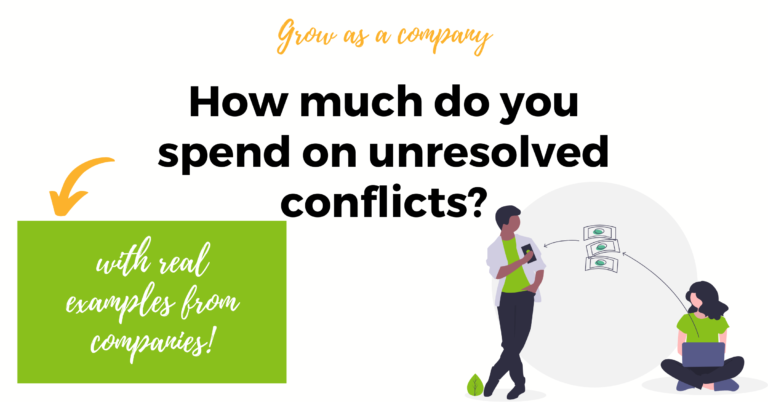Conflict costs are all costs a company has as a result of a conflict. They include costs for conflict resolution, a decrease of motivation, time spent dealing with conflict, loss of clients due to conflicts in the team, the image of the company, interrupted decision making, absenteeism, turnover, a decrease in productivity, and much more.
To get an idea of how high conflict costs can be for your company:
KPMG (2009) found the following results from a survey of 4,000 industrial companies:
- 10-15% of the working time is used for conflict resolution in every company.
- 30-50% of the weekly working hours of executives are spent directly or indirectly with frictional losses, conflicts, or the consequences of conflict.
- The average cost per bullying case is 60,000 euros.
- 1% of employee costs pa are lost for unprocessed conflicts.
- Approx. 25% of sales depend on the quality of communication.
Functional or dysfunctional conflict costs?
KPMG (2009) divides the conflict costs into functional and dysfunctional conflict costs. Positive costs (e.g. for conflict management or further development of the company) are referred to as functional conflict costs. They are an investment that you can expect a positive ROI for.
Negative costs without any benefit for the company as dysfunctional conflict costs. They include costs for turnover, decrease in productivity, loss of clients, decrease of motivation, absenteeism etc.
Conflicts always cost money. However, companies can influence how high those costs are and determine how they want to invest their money. The question is: As a company, do I want to control expenses myself and see a positive output for my investment?
Examples for functional or positive costs of conflicts
- Implementation of an In-house conflict management system
- Mediation
- Consulting
- Training for leaders and employees
- Organizational development
Examples for dysfunctional or negative costs of conflicts
- Turnover
- Absenteeism
- Mistakes
- Loss of clients and/or orders
- labor law-related sanctions
- counterproductive behavior
- decrease of productivity
- increase of duration of projects
- project failure
- difficulties to recruit qualified employees
How to calculate the costs of dealing with conflict in your own company
If you want a quick estimation of how much conflict in your team might be costing you, click here to try out the conflict cost calculator from resologics.
If you want to work with your own numbers, you could use the KPMG-model to determine how high the costs are: KPMG (2009) defines 9 categories of conflict costs. In 2011, Unternehmerschaft Düsseldorf (a German entrepreneurship association) published several real-life examples of how to calculate the cost of conflicts using these categories.
Here’s one example:

You can find more examples by clicking here to see the full report.
Help! We have high negative costs because of conflicts in our organization!
Every company has conflicts and when managed right they often even have huge benefits for companies. However, if you find that conflicts in your company are not dealt with in a productive manner and they are having negative consequences for the company and the employees, it’s time to act.
Possible measures:
- business mediation
- coaching
- training
- organizational development
What I experience as an organizational psychologist and mediator is that often just small measures already have a huge effect. Employees need to know that they are not left alone with their challenges.
Choose the right measures for your situation and your organization
It doesn’t make any sense to spend two days at a spa for a team building if two of your team members are having difficulties in their relationship with each other. At best, you are wasting time and money. In the worst case, the existing conflict will escalate, involve the whole team, create new conflicts and you will have a decrease of motivation in the whole team.
This doesn’t mean that team building measures are never right – on the contrary. They are right for – surprise – team building but not for managing conflict.
Another example: Even though I, as a mediator, really believe in mediation, I sometimes advise against it. Why? Because if for example the conflict was caused by unclear processes and structures, asking team members to participate in a mediation process would be a waste of energy and not deliver the results we are looking for. Instead, we use the time to figure out how to fix those processes to avoid conflicts in the future.


Responses
128812 609841Youre so cool! I dont suppose Ive learn something like this before. So great to search out any person with some distinctive thoughts on this subject. realy thanks for starting this up. this web site is one thing thats wanted on the net, somebody with a bit originality. useful job for bringing one thing new to the internet! 189600
… [Trackback]
[…] Read More here to that Topic: dardo-consulting.com/leadership/cost-of-conflict-in-the-workplace/ […]
… [Trackback]
[…] Find More on to that Topic: dardo-consulting.com/leadership/cost-of-conflict-in-the-workplace/ […]
… [Trackback]
[…] Read More Information here to that Topic: dardo-consulting.com/leadership/cost-of-conflict-in-the-workplace/ […]
… [Trackback]
[…] Read More here to that Topic: dardo-consulting.com/leadership/cost-of-conflict-in-the-workplace/ […]